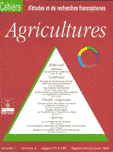Données techniques et socio-écon+B1421omiques sur les fromageries artisanales en République centrafricaine
Résumé
In a country with no cheese-making tradition whatsoever and a diminished local market for milk, establishing a camp-sized cheese dairy paved the way to a larger market and increase the family budget. This transfer of technology was successfully completed in two months and resulted in the dairy's independence from production right through to marketing. Unable to profit from their dairy cows because of the chronic shortage of sales for their milk, the Mbororo farmers' womenfolk were reduced to the uncomfortable situation of contributing a mere 3 % to the family budget. Since 92 % of the family budget comes from selling cattle, it is subject to the ups and downs of the market. Breaking into a new market by elaborating a new product, cheese, was thus a means to generate extra revenue, diversify the family's income and enhance their own status. Following a feasibility study and a survey of the women's problems and requirements in dairy products, a site was decided upon according to: - Technical criteria: the need for 40 litres of milk per day for cheese-making trials; - Social criteria: the need obtain a group consensus of opinion as to manufacture of the new product, as well as the agreement of the men as to this new independence of their women... This stage was vital to ensure the operation succeeded since everything depended on the idea being accepted by all. Accepting it was relatively easy since most men were already members of a farm cooperative (Groupement d'Intérêt Pastoral). Starting up: - Construction of a simple, but safe, functional and hygienic building at a cost of 90,000 CFA francs, and the purchase of 30,000 CFA francs' worth of equipment. - The setting aside of a working capital of 60,000 CFA francs allowing milk to be purchased for a month (cheese refining period) through contributions from the women and a loan from the cooperative. - Organising an office for the dairy and choosing two young women to be trained in cheese-making. With the help of a specialist in dairy technology for two months, two types of cheese were tested (Cheddar and Feta). After 15 days, the Feta was abandoned because of mould problems due to the moist climate, and the Cheddar decided upon. The specialist then put the finishing touches to the cheese's adaptation to local conditions and trained three further instructors. These latter were to train young women from the camp and any future dairies to be created. The specialist trained one of the three in milk transformation and testing to ensure the milk and cheese qualifies were satisfactory, and the other two in cheese-making. With 1 litre of milk per cow and on average two extra cows milked per woman, a camp may have some 40 litres of milk per day. The working capital allowed for the daily purchase of milk brought in by the camp women; this averaged at 4 000 CFA francs per day (100 CFA francs per litre) for 13 days per month. Cheese-making took place in the morning and the cheese remained in the press until the following day when it was removed from the mould and left to dry for refining. The three instructors trained the two young women until they were fully independent and able to make the cheese alone. Managing the dairy was also done by the women of the cooperative. Once trained, the young women were paid 150 CFA francs per kilo of cheese. Marketing the cheese was done by the cooperative which became the dairy's main client. The dairy dealt with transport to the cooperative. To fit every pocket, the cheese is small and available in 400-g and 600-g sizes. With an average of 2 litres of milk sold per woman per day and a cheese yield of 1 kg per 10 l milk, the dairy was able to buy 5 894 litres of milk an produce 588 kg cheese and generate an added value of 256,000 CFA francs and monetary revenue of 8 % (70,000 CFA francs). Breakdown of the selling price is as follows: Purchase of milk 1 002 CFA francs Other imput 61 CFA francs Salaries 150 CFA francs Loan repayments 85 CFA francs Amortisement 82 CFA francs Profit 120 CFA francs Price per kilo 1 500 CFA francs Repercussions on the family budget The fact of having found an outlet for the cheese allows each woman to sell two extra litres of milk per day and increase the family's annual budget by 4.3 %. The women's contribution to the budget more than doubles and goes from 3 to 7.1 %. In families where milk was already sold, the contribution rose from 11.7 to 15.3 %. For poor families, this new source of money enabled the budgets to be rebalanced. In all cases, the dairy improved the family budget and enhanced the women's status. The future The main improvement is to increase the number of collection days from 13 to 25 or 30 per month. Better organisation and full-time operation would double today's output. Each family still has lactating cows that remain unmilked. A short-term target is to regularise milk production over the year by complementary feed based on cotton seed. The women have already demonstrated their desire to increase their earnings as well as their ability to organise themselves for making cheese; perhaps they will be able to set up the food complement system for their dairy cattle and lay the foundations for the intensification and transformation of their production systems.Téléchargements
Publié
1992-09-01
Comment citer
Le Masson, A. . (1992). Données techniques et socio-écon+B1421omiques sur les fromageries artisanales en République centrafricaine. Cahiers Agricultures, 1(4), 270–277 (1). Consulté à l’adresse https://revues.cirad.fr/index.php/cahiers-agricultures/article/view/29759
Numéro
Rubrique
Articles

